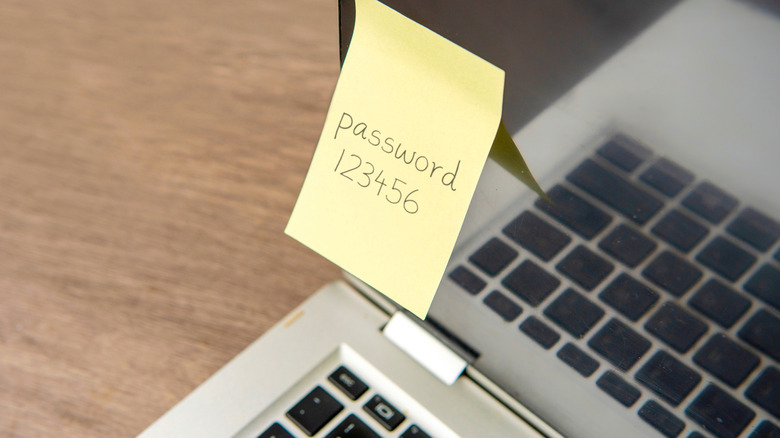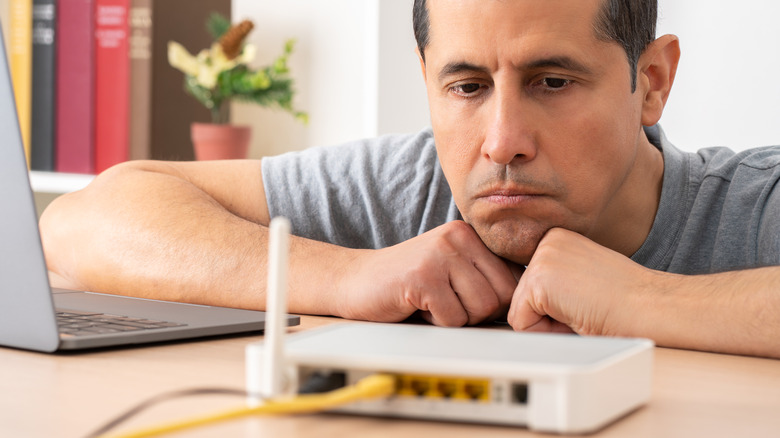The Easy Way To Connect To A Wi-Fi Network When You Forget Your Password
When you forget a Wi-Fi password, sometimes the world kind of grinds to a halt. Like it or not, we're all pretty committed to our connectedness. After all, even off-grid homesteaders need to upload shorts to their YouTube channels. And it becomes legitimately serious business if you have a smart home or are trying to establish a productive home office.
The longer you've had a password, the less likely you are to remember it. You save it to your phone or computer and don't think about it again. Or perhaps you're using a friend's or family member's network and forgot the password immediately after putting it in your phone at last year's Thanksgiving get-together. But now you have a new tablet or phone or laptop and you need to get online so you can share that video about everyone's over-dependence on technology.
Fortunately, there are many ways to get this done. The easiest of these involves using a device that already has the password stored in it, like that phone from last Thanksgiving. Others require you to be in the same room as the Wi-Fi router itself. But none of it is particularly difficult.
Reconnecting without a person to help
If you're at work and need a Wi-Fi password, you'd naturally just ask someone nearby or — if you're up for a long conversation about how someone's too busy to answer quick questions — ask a network administrator. But sometimes, there's no one there to help. Perhaps you're at home, or visiting someone who hasn't bothered to create a guest-friendly home. If you can connect to the network on another phone or computer, your problem might be solved. The easiest way to find the password is to retrieve it from that device's settings.
On Apple's iOS, this is simply a matter of navigating to Settings, Wi-Fi, then your network name (SSID). Tap on the obscured password, enter your security code, and it will show you the password saved for that network. On a recent Mac, click Apple menu, System Settings, Network, Wi-Fi, and Advanced, then click More (three dots) by the network's name, and click Copy Password. You can then paste it into a text editor to see it in clear text. On Windows 11, click your way through to Settings, Network & Internet, Wi-Fi, then your network. Click the Show button next to "Wi-Fi network password" to see your saved password. On Windows 10, some security protocols will allow you to reveal the Wi-Fi password. Click Settings, Network & Internet, Wi-Fi, Network and Sharing Center, SSID, Wireless Properties, Security, and check the "Show characters" box under the Network security key. On Android devices, open Settings, Network & Internet/Connections, and Wi-Fi, then select the network's name and tap Share to view the password.
Getting physical with the Wi-Fi router
If you can put your hands on the Wi-Fi router itself, you have a couple of additional options. For a consumer router model, you might find on its back a default password that still works if the owner has ignored guidance about how to make your Wi-Fi safer. Or, better yet, a QR code you can scan. The QR code approach replaced the older Wi-Fi Protected Setup (WPS) method that involved pressing a button marked, unsurprisingly, WPS, then automatically connecting your device. WPS had some serious security issues, but might still work for older phone and router combinations. Your phone must usually be configured to make WPS connections, and support for WPS was discontinued in Android 9.
Your almost-last-ditch option is to desperately look for a person who can find the password for you. This might be your spouse or a third cousin or a network administrator, depending on the network you're trying to access. How you find such a person depends on how loud you're willing to be. Consider being very loud, because the truly last-ditch, nuclear option is to push the magic button on the router labeled "factory reset" ... at which point you will become the only person who can connect to the network anymore. It's not an ideal way to win friends, but it will usually make the password printed on the router work and give you access again. But there's also a chance you'll nuke some settings and kill your internet connection anyway, in which case you'll have to go a step further than nuclear and call your internet service provider.


